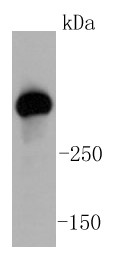ATM antibody [2C1] (supernatant)
GTX77613
ApplicationsImmunoFluorescence, ImmunoPrecipitation, Western Blot, ImmunoCytoChemistry, ImmunoHistoChemistry, ImmunoHistoChemistry Paraffin
Product group Antibodies
TargetATM
Overview
- SupplierGeneTex
- Product NameATM antibody [2C1] (supernatant)
- Delivery Days Customer9
- Application Supplier NoteRecommended Starting Dilutions:For WB: Use at 1:100. For IP: Use at an assay dependent dilution. For IHC: Use at 1:50. Analysis was performed of the cerebral cortex of E14.5 wild-type (+/+) and scid mice - (MC Vemuri, 2001) For immunofluorescence please refer to the publication by Harry Scherthan, et.al., 2000 and Yiyoung Liu, et.al., 2006. For ICC/IF: Use at 1:500. Optimal dilutions/concentrations should be determined by the researcher.
- ApplicationsImmunoFluorescence, ImmunoPrecipitation, Western Blot, ImmunoCytoChemistry, ImmunoHistoChemistry, ImmunoHistoChemistry Paraffin
- CertificationResearch Use Only
- ClonalityMonoclonal
- Clone ID2C1
- ConjugateUnconjugated
- Gene ID472
- Target nameATM
- Target descriptionATM serine/threonine kinase
- Target synonymsAT1, ATA, ATC, ATD, ATDC, ATE, TEL1, TELO1, serine-protein kinase ATM, A-T mutated, AT mutated, TEL1, telomere maintenance 1, homolog, ataxia telangiectasia mutated, serine/threonine kinase ATM
- HostMouse
- IsotypeIgG1
- Protein IDQ13315
- Protein NameSerine-protein kinase ATM
- Scientific DescriptionThe protein encoded by this gene belongs to the PI3/PI4-kinase family. This protein is an important cell cycle checkpoint kinase that phosphorylates; thus, it functions as a regulator of a wide variety of downstream proteins, including tumor suppressor proteins p53 and BRCA1, checkpoint kinase CHK2, checkpoint proteins RAD17 and RAD9, and DNA repair protein NBS1. This protein and the closely related kinase ATR are thought to be master controllers of cell cycle checkpoint signaling pathways that are required for cell response to DNA damage and for genome stability. Mutations in this gene are associated with ataxia telangiectasia, an autosomal recessive disorder. [provided by RefSeq, Aug 2010]
- Storage Instruction-20°C or -80°C,2°C to 8°C
- UNSPSC12352203
References
- Sible E, Attaway M, Fiorica G, et al. Ataxia Telangiectasia Mutated and MSH2 Control Blunt DNA End Joining in Ig Class Switch Recombination. J Immunol. 2023,210(4):369-376. doi: 10.4049/jimmunol.2200590Read this paper
- Li J, Zhao H, McMahon A, et al. APE1 assembles biomolecular condensates to promote the ATR-Chk1 DNA damage response in nucleolus. Nucleic Acids Res. 2022,50(18):10503-10525. doi: 10.1093/nar/gkac853Read this paper
- Zhang Y, Ou G, Ye Z, et al. RPRM negatively regulates ATM levels through its nuclear translocation on irradiation mediated by CDK4/6 and IPO11. iScience. 2022,25(10):105115. doi: 10.1016/j.isci.2022.105115Read this paper
- Kim YH, Jo DS, Park NY, et al. Inhibition of BRD4 Promotes Pexophagy by Increasing ROS and ATM Activation. Cells. 2022,11(18). doi: 10.3390/cells11182839Read this paper
- Li J, Ding R, Gao H, et al. New spirobisnaphthalenes from an endolichenic fungus strain CGMCC 3.15192 and their anticancer effects through the P53-P21 pathway. RSC Adv. 2019,9(67):39082-39089. doi: 10.1039/c9ra07917cRead this paper
- Wang F, Jin S, Mayca Pozo F, et al. Chemical screen identifies shikonin as a broad DNA damage response inhibitor that enhances chemotherapy through inhibiting ATM and ATR. Acta Pharm Sin B. 2022,12(3):1339-1350. doi: 10.1016/j.apsb.2021.08.025Read this paper
- Yang SC, Chen HY, Chuang WL, et al. Different Cell Responses to Hinokitiol Treatment Result in Senescence or Apoptosis in Human Osteosarcoma Cell Lines. Int J Mol Sci. 2022,23(3). doi: 10.3390/ijms23031632Read this paper
- Zhang L, Geng X, Wang F, et al. 53BP1 regulates heterochromatin through liquid phase separation. Nat Commun. 2022,13(1):360. doi: 10.1038/s41467-022-28019-yRead this paper
- Bulut-Karslioglu A, Jin H, Kim YK, et al. Chd1 protects genome integrity at promoters to sustain hypertranscription in embryonic stem cells. Nat Commun. 2021,12(1):4859. doi: 10.1038/s41467-021-25088-3Read this paper
- Teng YN, Chang HC, Chao YY, et al. Etoposide Triggers Cellular Senescence by Inducing Multiple Centrosomes and Primary Cilia in Adrenocortical Tumor Cells. Cells. 2021,10(6). doi: 10.3390/cells10061466Read this paper




![IHC-P analysis of rat spleen tissue section using GTX01544 ATM antibody [GT1218]. Dilution : 1:100](https://www.genetex.com/upload/website/prouct_img/normal/GTX01544/GTX01544_20200508_IHC-P_w_23053121_279.webp)